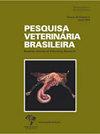巴西东北部绵羊的低钠血症
IF 0.8
4区 农林科学
Q3 VETERINARY SCIENCES
引用次数: 0
摘要
摘要:矿物质缺乏是反刍动物生产损失的重要原因,尤其是在半干旱地区。本研究旨在测定巴西东北部半干旱地区饲养的绵羊血清中Na、K和Cl的浓度,以及唾液中Na和K的浓度,并报道绵羊低钠血症暴发的流行病学、临床和病理方面的情况。为此,在该地区6个不同的农场收集了55只羊的血清和唾液样本。钠、钾和氯浓度采用比色法测定,使用商用试剂盒在半自动生化分析仪中测定。Na的平均血清浓度为131.5±13.1mEq/L ~ 172.4±9.3mEq/L, K的平均血清浓度为6.28±1.3mEq/L ~ 13.9±1.4mEq/L, Cl的平均血清浓度为91.6±54.8mEq/L ~ 113.6±1.5mEq/L。唾液中Na的平均浓度为119.4±9.5mEq/L ~ 161.8±15.2mEq/L, K的平均浓度为10.1±3.1mEq/L ~ 22.3±2.3mEq/L, Na:K比值为6.0±1.3mEq/L ~ 11.8±4.1mEq/L。这些结果表明,在该地区的农场饲养的大多数羊的钠是轻微的枯竭。在一个农场,羊有严重的缺钠临床症状,包括外表憔悴、爱吃盐、渴渴、多尿、干咳、食欲不振、异食癖、虚弱、站立和行动困难、严重消瘦和脱水。尸检发现,瘤胃内容物普遍受到影响,使内容物具有粘土球的特征。4只羊出现肾上腺肥大。组织病理学上,肾小球带宽度扩大,结构丧失,肾上腺皮质细胞索丧失。肾小球带和束状带上皮细胞呈锥体状,胞浆嗜酸性高,细胞核深染。这些数据表明,在伯南布哥州的绵羊养殖场发生了不同程度的钠缺乏症,并强调了提供NaCl以避免低钠血症爆发的重要性。本文章由计算机程序翻译,如有差异,请以英文原文为准。
Hyponatremia in sheep in Northeastern Brazil
ABSTRACT: Mineral deficiencies are important causes of productive losses in ruminant farming, especially in semiarid regions. This study aimed to determine Na, K, and Cl serum concentrations, plus the salivary concentrations of Na and K in sheep raised in a semiarid region of Northeastern Brazil, and to report the epidemiology, clinical and the pathological aspects of an outbreak of hyponatremia in sheep. For this, serum and salivary samples of 55 sheep were collected in 6 different farms in the region. Na, K, and Cl concentrations were determined by colorimetric test, using commercial kits in a semi-automatic biochemical analyzer. The mean serum concentrations ranged from 131.5±13.1mEq/L to 172.4±9.3mEq/L for Na, 6.28±1.3mEq/L to 13.9±1.4mEq/L for K, and 91.6±54.8mEq/L to 113.6±1.5mEq/L for Cl. The mean salivary concentrations ranged from 119.4±9.5mEq/L to 161.8±15.2mEq/L for Na, 10.1±3.1mEq/L to 22.3±2.3mEq/L for K, and the ratio Na:K ranged from 6.0±1.3mEq/L to 11.8±4.1mEq/L. These results revealed that most sheep raised in the farms in this region are marginally depleted in sodium. In one farm, sheep had severe clinical signs of Na deficiency consisting of haggard appearance, craving for salt, polydipsia, polyuria, dry cough, inappetence, pica, weakness, difficulty to rise and move, severe emaciation, and dehydration. On autopsy, the ruminal content was generally impacted, giving to the content an aspect of clay balls. Four sheep presented hypertrophy of the adrenal glands. Histopathologically, the width of the zona glomerulosa was expanded, there was loss of the architecture and loss of adrenocortical cell cords. The epithelial cells in the zona glomerulosa and fasciculata were pyramidal, and contained hypereosinophilic cytoplasm and hyperchromatic nuclei. These data demonstrate the occurrence of Na deficiency in different degrees in sheep farms in the State of Pernambuco and highlight the importance of providing NaCl to avoid outbreaks of hyponatremia.
求助全文
通过发布文献求助,成功后即可免费获取论文全文。
去求助
来源期刊

Pesquisa Veterinaria Brasileira
农林科学-兽医学
CiteScore
1.30
自引率
16.70%
发文量
41
审稿时长
9-18 weeks
期刊介绍:
Pesquisa Veterinária Brasileira - Brazilian Journal of Veterinary Research (http://www.pvb.com.br), edited by the Brazilian College of Animal Pathology in partnership with the Brazilian Agricultural Research Organization (Embrapa) and in collaboration with other veterinary scientific associations, publishes original papers on animal diseases and related subjects. Critical review articles should be written in support of original investigation. The editors assume that papers submitted are not being considered for publication in other journals and do not contain material which has already been published. Submitted papers are peer reviewed.
The abbreviated title of Pesquisa Veterinária Brasileira is Pesqui. Vet. Bras.
 求助内容:
求助内容: 应助结果提醒方式:
应助结果提醒方式:


